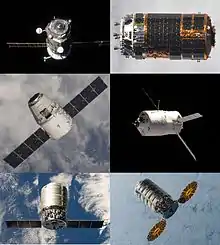Cygnus NG-19
NG-19 is the nineteenth planned flight of the Northrop Grumman robotic resupply spacecraft Cygnus and its eighteenth flight to the International Space Station (ISS) under the Commercial Resupply Services (CRS-2) contract with NASA. The mission is scheduled to launch in July 2023.[1] This is the eighth launch of Cygnus under the CRS-2 contract.[2][3]
 Artists' impression of an Extended Cygnus; the spacecraft type to be used in the mission. | |
| Mission type | ISS logistics |
|---|---|
| Operator | Northrop Grumman |
| Spacecraft properties | |
| Spacecraft | S.S. Laurel Clark |
| Spacecraft type | Enhanced Cygnus |
| Manufacturer |
|
| Start of mission | |
| Launch date | July 2023 (planned)[1] |
| Rocket | Antares 230+ |
| Launch site | Wallops Pad 0A |
| Contractor | Northrop Grumman |
| End of mission | |
| Disposal | Deorbited |
| Decay date | 2023 (planned) |
| Orbital parameters | |
| Reference system | Geocentric orbit |
| Regime | Low Earth orbit |
| Inclination | 51.66° |
| Berthing at the International Space Station | |
| Berthing port | Harmony or Unity |
 Cygnus NG-19 mission patch | |
Orbital ATK (now Northrop Grumman Innovation Systems) and NASA jointly developed a new space transportation system to provide commercial cargo resupply services to the International Space Station (ISS). Under the Commercial Orbital Transportation Services (COTS) program, Orbital ATK designed, acquired, built, and assembled these components: Antares, a medium-class launch vehicle; Cygnus, an advanced spacecraft using a Pressurized Cargo Module (PCM) provided by industrial partner Thales Alenia Space and a Service Module based on the Orbital GEOStar satellite bus.[4]
History
Cygnus NG-19 is the eighth Cygnus mission under the Commercial Resupply Services-2 contract. Northrop Grumman Innovation Systems confirmed on 23 February 2021 that Thales Alenia Space of Turin, Italy, will fabricate two additional Pressurized Cargo Modules (PCMs) for a pair of forthcoming Commercial Resupply Services-2 missions. Current plans are for the two additional Cygnus spacecraft to be designated NG-18 and NG-19.[5]
Production and integration of Cygnus spacecraft are performed in Dulles, Virginia. The Cygnus service module is mated with the pressurized cargo module at the launch site, and mission operations are conducted from control centers in Dulles, Virginia and Houston, Texas.[4]
Manifest
The Cygnus spacecraft is loaded with 0 kg (0 lb) of research, hardware, and crew supplies.[7]
- Crew supplies: 0 kg (0 lb)
- Science investigations: 0 kg (0 lb)
- Spacewalk equipment: 0 kg (0 lb)
- Vehicle hardware: 0 kg (0 lb)
- Computer resources: 0 kg (0 lb)
Research
The new experiments arriving at the orbiting laboratory will inspire future scientists and explorers, and provide valuable insight for researchers.
NASA Glenn Research Center studies: [8]
- TBD
References
- Clark, Stephen (15 April 2023). "Launch Schedule". Spaceflight Now. Retrieved 15 April 2023.
- Gebhardt, Chris (1 June 2018). "Orbital ATK looks ahead to CRS-2 Cygnus flights, Antares on the commercial market". NASASpaceflight.com. Retrieved 4 April 2021.
- Clark, Stephen (1 October 2020). "Northrop Grumman "optimistic" to receive more NASA cargo mission orders". Spaceflight Now. Retrieved 4 April 2021.
- "Cygnus Spacecraft". Northrop Grumman. 6 January 2020. Retrieved 4 April 2021.
- Evans, Ben (23 February 2021). "Northrop Grumman Green-Lights Two More Cygnus Missions, As NG-15 Arrives at Space Station". AmericaSpace. Retrieved 4 April 2021.
- Leone, Dan (17 August 2015). "NASA Orders Two More ISS Cargo Missions From Orbital ATK". SpaceNews. Retrieved 4 April 2021.
- "Northrop Grumman Commercial Resupply". ISS Program Office. NASA. 1 July 2019. Retrieved 4 April 2021.
 This article incorporates text from this source, which is in the public domain.
This article incorporates text from this source, which is in the public domain. - "ISS Research Program". Glenn Research Center. NASA. 1 January 2020. Retrieved 4 April 2021.
 This article incorporates text from this source, which is in the public domain.
This article incorporates text from this source, which is in the public domain.

